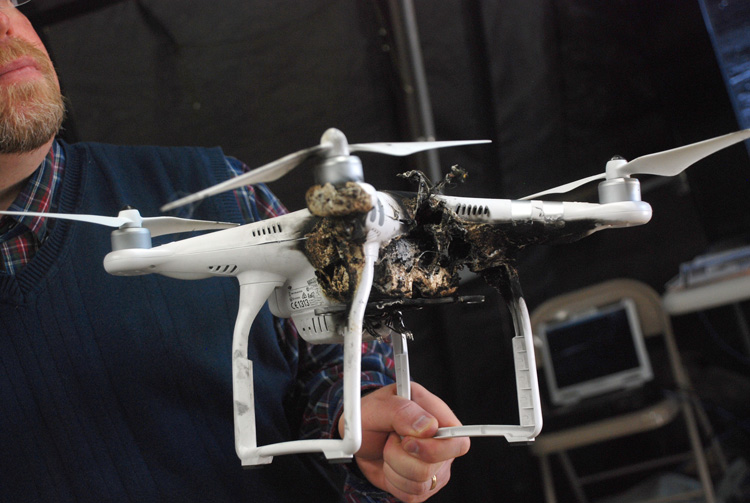Small consumer-scale drones “pose real and significant threats to military operations,” a report published in May by Ottawa-based defence scientists warns.

Sophisticated quadcopter drones are now being sold to hobbyists at around a $1,000 price point, the report says, a cost that could let a potential enemy treat it as “an affordable and expendable item.”
Well-funded Western militaries are embracing unpiloted aircraft — they’re attracted to the (relatively) low cost and flexibility of aircraft design that doesn’t need a human pilot.
For years, American drones, controlled from the United States by an officer with a joystick, have flown over Afghanistan and Pakistan destroying targets at will. Britain’s futuristic, remote-controlled Taranis jet may turn out to show that the future of fighter jets doesn’t involve fighter pilots. The U.S. Navy is testing submarine-launched reconnaissance drones and swarms of small drones that fly around in groups.
But if this is the future of war for rich countries, small quadcopters, like those you can buy at hobby stores in Canada, are being adopted by guerrilla armies.
Small drones have been used by all sides in the conflicts in Syria and Ukraine. Mostly they have been used for intelligence-gathering, but there have been instances in Syria of quadcopters dropping grenade-sized explosives.
Here, a Hezbollah drone appears to drop explosives on a target in Syria:
In 2015, supporters of Ukraine’s underfunded army, in an unequal battle with better-equipped Russian forces, launched a crowdfunding effort to buy them small drones.
German police have investigated cases both of Islamic terrorists planning to use drones in attacks and also extreme right-wing groups planning to use drones to attack Muslims. There are numerous cases of drones being used to fly drugs across the U.S.-Mexican border.
So if Canada ends up being involved in a guerrilla war like the one that raged for 13 years in Afghanistan, it’s reasonable to expect big, expensive drones to be used on one side, and small, cheap ones to be used on the other.
It falls into a long tradition of guerillas making do with cheap weapons, explains Col. Paul Taillon, who teaches at the Royal Military College in Kingston.
“It’s the same all the way through history. I am weak and they are strong. How do I make it balance?”
Taillon, who served three tours in Afghanistan, says that Canadian troops didn’t face Taliban drones in the high-intensity phase of the Afghan war, up to about 2010, because they weren’t as available then.
But, given the Taliban’s control of the drug trade, they could easily afford them now:
“If there are drones on the market, and you have money, you purchase them. They are very astute about their use of technology.”
The report, published by Defence Research and Development Canada, a research arm of the defence department, looked at the problem of how Canadian troops could find a tiny drone that was spying on them.
One major problem is telling small drones apart from birds, which could potentially be bigger than drones and emit heat, just as drones do. Detecting the radio communication between the drone and its controller seemed to be the best solution.
READ MORE: Drones plague Canadian airports. But are promised rules the solution?
Defence officials could not provide somebody to interview.
“Drones have increasingly become mainstream and can be used for various applications,” defence department spokesperson Daniel Le Bouthillier wrote in an e-mail. “They are small in size, making them hard to detect and can legitimately impact military operations.”
The Canadian report dealt only in passing with how a drone, once found, could be attacked, but earlier this year U.S. Army researchers said they focused a high-power laser beam on a drone until it burst into flame.
- Train goes up in flames while rolling through London, Ont. Here’s what we know
- Wrong remains sent to ‘exhausted’ Canadian family after death on Cuba vacation
- Liberals having ‘very good’ budget talks with NDP, says Freeland
- Budget 2024 failed to spark ‘political reboot’ for Liberals, polling suggests
The report recommended that defence scientists start experimenting with ways of detecting drones.
WATCH: Police forces in the Netherlands are combating drones by training eagles to swoop in and take them down. Emily Elias has the story.

A U.S. Army manual published in July looked more broadly at the threat posed by small drones.
Acknowledging that small drones are “small and elusive” and “difficult to detect,” the unsigned manual looked at various ways that troops could be attacked with quadcopters, as well as spied on.
Small drones are cheap, hard to see and hard to destroy, it warns. They are “available to financially limited, rogue or failing states or non-state actors” and “generally very small, making them hard to hit with direct fire weapons.”
Used as weapons, they could “carry the improvised explosive device or become the improvised explosive device.” They could also be used by guerillas some distance away to choose the ideal moment to set off a roadside bomb.
Given their low cost, a swarm of drones could be sacrificed to attack a helicopter, most likely by flying into its blades, a scenario the manual called “perhaps the most dangerous course of action”.
“Swarming is a very valuable tactic against a valuable target,” Taillon explains. “Your target acquisition systems are inundated, and you just can’t destroy them all. You’re overrun.”
“Something is going to hit. Quantity has its own beauty.”



Comments